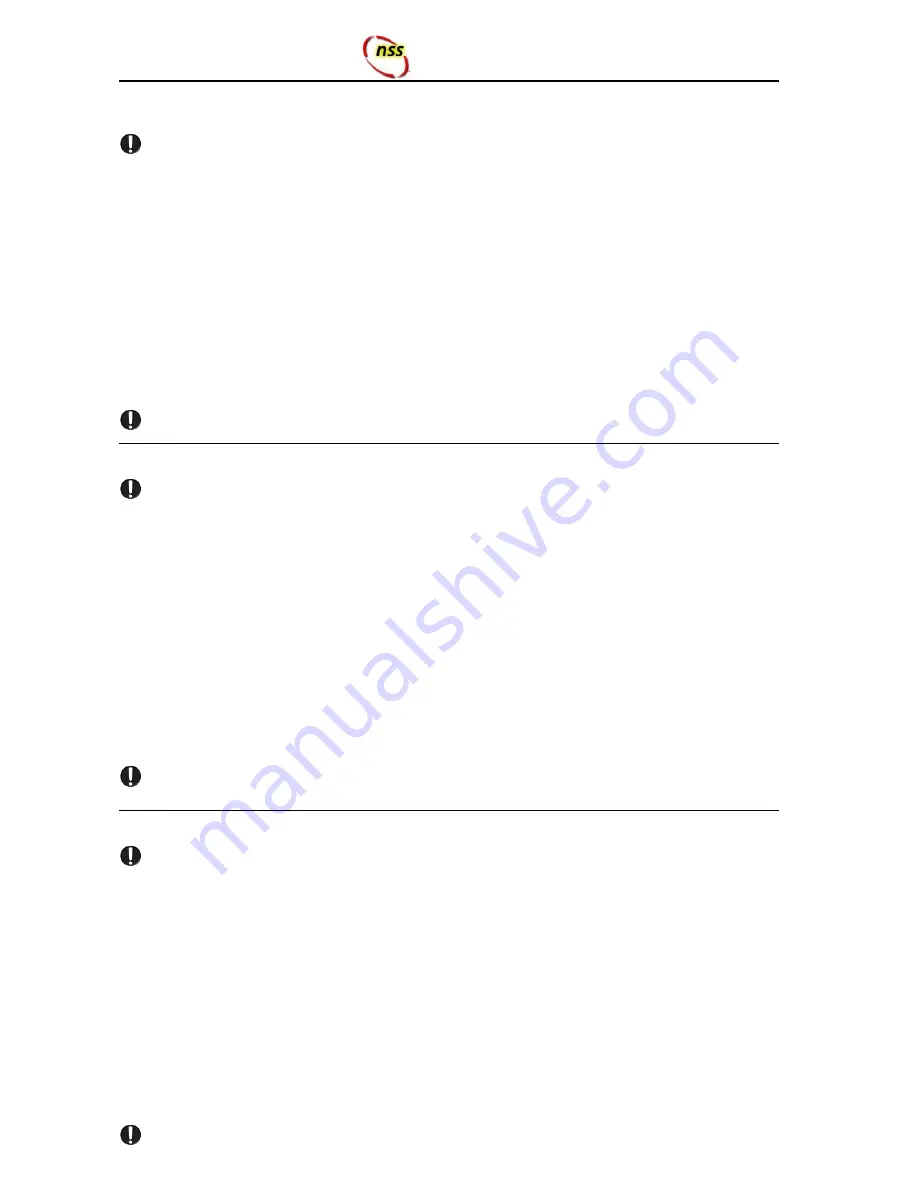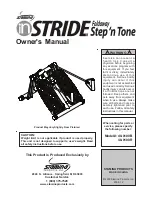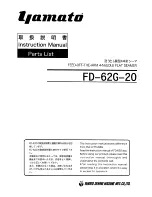
38
Manta RS 36
MAIN BRUSH
The main brush sweeps dust and refuse into the bin at the rear of the motor-sweeper.
Caution! Never sweep up string, wire, etc., which can become entangled in the brush and damage the bristles.
Adjusting the main brush
The main brush is raised and lowered by lever 2, fig. 3.The main brush is mounted in a floating mechanism.The main brush should just touch the floor,
leaving a trace 3 cm wide when it rotates (fig.9).If the main brush leaves lines of dirt, it has worn down and must be lowered. Proceed as follows to lower
the main brush:
•
Undo the nut 2 fig. 8
•
Turn the Knob 1anti-clockwise until the trail left by the main brush measures about 3 cm.
•
Retighten the nut 2.
•
Check the width of the trace as shown in fig. 9.
Checking and replacing the primary brush drive belt 6 (fig. 7)
Every 100 - 150 hours work, check the condition of the primary brush drive belt 6.Belt tension is registered by tensioner 5.If the belt 6 is visibly worn fit a new
belt as follows:
•
Remove the right-hand side cover 1.
•
Back off the belt stretcher 2 of the transmission belt 3.
•
Remove the transmission belt 3 from the pulley 4.
•
Back off the belt stretcher 5 of the main brush drive belt 6.
•
Replace the main brush belt 6.
•
Tension the belt 6 using the belt stretcher 5.
•
Replace the belt 3 on the pulley 4.
•
Tension the belt 3 using the belt stretcher 2.
•
Replace the side cover 1.
When the belt is replaced, the brush drive belts 3 and 7 (fig. 7) should also be checked. If belts show signs of wear, replace them to avoid further down-
times for more dismantling of parts.
CEPILLO CENTRAL
El cepillo central es la pieza que carga la basura en el contenedor posterior.
Atención! No recoger nunca cuerdas, alambres, etc. puesto que podrían enrollarse en el cepillo y deteriorar las cerdas.
Regulación del cepillo central
Para levantar y bajar el cepillo central hay que accionar la palanca 2 (Fig. 3).
El cepillo central está montado en un mecanismo flotante.
El cepillo central sólo debe rozar el suelo, dejando una marca de 3 cm de ancho a lo largo de su trayecto (Fig. 9).
Cuando el cepillo central deja restos de suciedad durante su funcionamiento, debe bajarse regulándolo de la siguiente manera:
•
Aflojar la contratuerca 2 (Fig. 8).
•
Girar el pomo 1 hacia la izquierda hasta que la marca del cepillo central sea de unos 3 cm.
•
Volver a apretar la tuerca 2.
•
Comprobar la marca (véase Fig. 9).
Tensado de la correa 6 de accionamiento del cepillo central y sustitución (Fig. 7)
Cada 100 - 150 horas de funcionamiento comprobar la tensión y el grado de desgaste de la correa 6. La tensión se regula mediante el tensor de correa 5.
Si la correa 6 está desgastada, sustituirla de la siguiente manera (Fig. 7):
•
Desmontar la tapa lateral derecha 1.
•
Aflojar el tensor 2 de la correa de transmisión 3.
•
Quitar la correa de transmisión 3 de la polea 4.
•
Aflojar el tensor de correa 5 de la correa de accionamiento del cepillo central 6.
•
Sustituir la correa del cepillo central 6.
•
Tensar la correa 6 con el tensor de correa 5.
•
Volver a montar la correa 3 en la polea 4.
•
Tensar la correa 3 con el tensor 2.
•
Volver a montar la tapa lateral 1.
Cuando se sustituye la correa, comprobar también las correas de accionamiento de los cepillos 3 y 7 (Fig. 7). Si las correas están deterioradas,
sustituirlas a fin de evitar pérdidas de tiempo con otros desmontajes de piezas.
BALAI CENTRAL
Le balai central est la partie qui ramasse les déchets et les verse dans le bac arrière.
Attention! Ne jamais ramasser de fils, cordes etc...car ils peuvent endommager les soies s’ils s’enroulent au balai.
Réglage du balai central
Pour soulever et descendre le balai central, il faut agir sur le levier 2 (fig. 3).
Le balai central est flottant. Pour un bon fonctionnement, le balai doit frôler le terrain, en y laissant une trace de 3 cm de large (fig.9). Lorsque le balai central
laisse des traces de saleté pendant le fonctionnement, le faire descendre comme suit:
•
Desserrer l’ecrou 2 (Fig. 8)
•
Tourner le poignée 1 dans le sens contraire des aiguilles d’une montre jusqu’à ce que la trace du balai central soit d’environ 3 cm.
•
Revisser l’ecrou 2
•
Effectuer le test de la trace, voir fig. 8.
Tension courroie 6 commande balai central et remplacement (Fig. 7)
Contrôler toutes les 100-150 heures de fonctionnement la tension et l’usure de la courroie 6. La tension est réglée à l’aide du tendeur de courroie 5.
Si la courroie 6 est usurée, la remplacer comme suit:
•
Démonter le panneau latéral droit 1.
•
Desserrer le tendeur 2 de la courroie de renvoi 3.
•
Retirer la courroie de renvoi 3 de la poulie 4.
•
Desserrer le tendeur 5 de la courroie de commande du balai central 6.
•
Changer la courroie du balai central 6.
•
Tendre la courroie 6 à l’aide du tendeur 5.
•
Remonter la courroie 3 sur la poulie 4.
•
Tendre la courroie 3 à l’aide du tendeur 2.
•
Remonter le panneau latéral 1.
Il est recommandé, lors du changement de la courroie, de vérifier également l’état des courroies de commande des balais 3 et 7 (Fig. 7).
Si elles devaient être détériorées, les changer afin d’éviter de nouveaux démontages de pièces occasionnant des pertes de temps.
Содержание Manta RS 36
Страница 2: ...2 Manta RS 36 Manta RS 36...
Страница 69: ...69 Manta RS 36 REMARKS OBSERVACI N NOTES BEMERKUNGEN NOTE...
Страница 70: ...MANTA...
Страница 71: ...MANTA...
















































